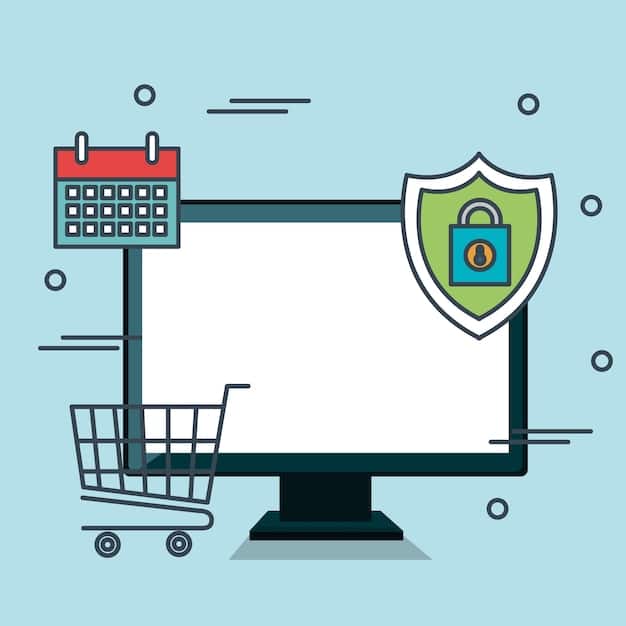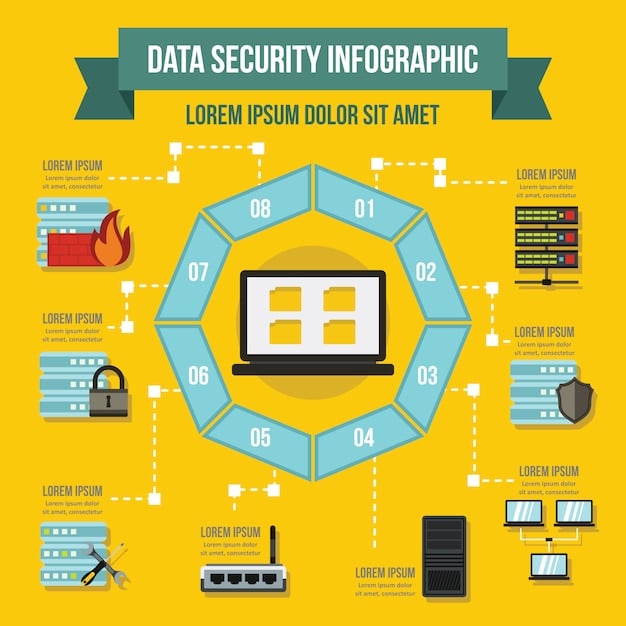PCI DSS Compliance for E-commerce: Avoid Fines & Breaches in 2025

Ensuring your e-commerce store’s PCI DSS compliance is crucial to avoid hefty fines and data breaches in 2025, protecting customer payment data and maintaining business trust.
In the ever-evolving landscape of online commerce, ensuring the security of your customers’ payment information is paramount. Are you sure that your e-commerce store is PCI DSS compliant? Avoid fines and data breaches in 2025 by understanding and implementing the necessary security measures.
What is PCI DSS Compliance?
Payment Card Industry Data Security Standard (PCI DSS) compliance is a set of security standards designed to protect cardholder data. It applies to all entities that store, process, or transmit cardholder data, including e-commerce stores. Understanding what PCI DSS entails is the first step towards achieving compliance.
Why is PCI DSS Compliance Important?
PCI DSS compliance is not just a regulatory requirement, it’s essential for maintaining the trust of your customers and protecting your business from significant financial and reputational damage. Failing to comply can result in hefty fines, legal repercussions, and a loss of customer confidence.
- Protects Cardholder Data: The primary goal of PCI DSS is to safeguard sensitive cardholder data from theft and fraud.
- Avoids Fines: Non-compliance can lead to substantial fines from payment card brands.
- Maintains Customer Trust: Compliance demonstrates a commitment to security, enhancing customer confidence.
- Prevents Data Breaches: Implementing PCI DSS reduces the risk of costly and damaging data breaches.
Complying with PCI DSS is a critical investment in the security and longevity of your e-commerce business. It ensures your customers feel safe when making purchases on your site.
Understanding the 12 PCI DSS Requirements
The PCI DSS framework consists of 12 core requirements that provide a roadmap for securing cardholder data. Each requirement is designed to address specific aspects of security, ranging from network protection to access control and data encryption. Let’s break down these requirements to provide a clearer understanding.

Overview of the 12 Requirements
These requirements are grouped into six control objectives, each addressing a key aspect of security. Understanding these objectives and their corresponding requirements is crucial for building a robust security posture.
- Build and Maintain a Secure Network and Systems: Includes installing and maintaining a firewall configuration to protect cardholder data, and changing vendor-supplied defaults for system passwords and other security parameters.
- Protect Cardholder Data: Focuses on protecting stored cardholder data and encrypting transmission of cardholder data across open, public networks.
- Maintain a Vulnerability Management Program: Involves using and regularly updating anti-virus software and developing and maintaining secure systems and applications.
- Implement Strong Access Control Measures: Consists of restricting access to cardholder data by business need-to-know, assigning a unique ID to each person with computer access, and restricting physical access to cardholder data.
- Regularly Monitor and Test Networks: Includes tracking and monitoring all access to network resources and cardholder data, and regularly testing security systems and processes.
- Maintain an Information Security Policy: Focuses on maintaining a policy that addresses information security for all personnel.
By meticulously addressing each of these requirements, businesses can create a secure environment for processing and storing cardholder data.
Steps to Achieve PCI DSS Compliance
Becoming PCI DSS compliant involves a structured approach. This includes assessing your current security posture, implementing necessary controls, and maintaining continuous monitoring and improvement. Following these steps will help you navigate the compliance process more effectively.
Assess Your Current Security Posture
Start by conducting a thorough assessment of your current security environment. Identify where cardholder data is stored, processed, and transmitted. This assessment will highlight any gaps in your security controls.
Implement Necessary Security Controls
Based on your assessment, implement the security controls required by PCI DSS. This may involve upgrading hardware and software, enhancing network security, and training employees on security best practices.
- Install and Maintain Firewalls: Protect your network by implementing robust firewall configurations.
- Encrypt Cardholder Data: Use encryption to protect cardholder data both in transit and at rest.
- Regularly Update Anti-Virus Software: Keep your anti-virus software up-to-date to protect against malware.
- Implement Strong Access Controls: Restrict access to cardholder data based on job function.
Implementing these controls is a critical step towards achieving and maintaining PCI DSS compliance.
Common Challenges in PCI DSS Compliance
While the path to PCI DSS compliance is well-defined, many e-commerce businesses face challenges along the way. These challenges range from understanding the requirements to implementing and maintaining the necessary security controls. Recognizing these challenges can help you prepare and mitigate potential issues.
Understanding the Requirements
Many businesses struggle with interpreting the PCI DSS requirements and applying them to their specific environment. The complexity of the standard and the need for specialized knowledge can be overwhelming.
Implementing and Maintaining Security Controls
Implementing the required security controls can be time-consuming and costly. Maintaining these controls over time requires ongoing effort and resources. Addressing these challenges effectively ensures continuous compliance.
- Lack of Resources: Many small businesses lack the resources to implement and maintain the required security controls.
- Complexity of the Standard: The PCI DSS standard is complex and can be difficult to interpret.
- Changing Technology: Keeping up with evolving technology and security threats can be challenging.
Addressing these challenges proactively can streamline the compliance process and ensure long-term security.
The Cost of Non-Compliance
The consequences of failing to comply with PCI DSS can be severe, extending beyond financial penalties to include reputational damage and legal repercussions. Understanding the potential costs can provide a strong incentive to prioritize compliance.

Financial Penalties
Payment card brands can impose substantial fines on businesses that fail to comply with PCI DSS. These fines can range from thousands to millions of dollars, depending on the severity and duration of the non-compliance.
Reputational Damage
A data breach resulting from non-compliance can severely damage your business’s reputation. Customers may lose trust in your ability to protect their data, leading to a decline in sales and customer loyalty.
- Fines from Payment Card Brands: Non-compliance can result in significant financial penalties.
- Legal Fees: Data breaches can lead to costly legal battles and settlements.
- Customer Compensation: You may be required to compensate customers affected by a data breach.
- Loss of Customer Trust: A data breach can erode customer trust and damage your brand’s reputation.
The financial and reputational costs of non-compliance far outweigh the investment required to achieve and maintain PCI DSS compliance.
Preparing for PCI DSS Compliance in 2025
As we approach 2025, it’s crucial to stay ahead of potential changes and updates to the PCI DSS standard. Proactive preparation will help you maintain compliance and ensure your e-commerce store remains secure. Keeping abreast of potential changes and updates to the PCI DSS standard is essential.
Stay Informed About Updates
Regularly monitor the PCI Security Standards Council website and other industry resources for updates to the standard. This will help you understand any new requirements or changes to existing ones.
Conduct Regular Security Assessments
Perform frequent security assessments to identify and address vulnerabilities in your systems and processes. This proactive approach will help you maintain a strong security posture.
- Monitor the PCI Security Standards Council Website: Stay informed about updates to the PCI DSS standard.
- Conduct Regular Vulnerability Scans: Identify and address potential security vulnerabilities.
- Implement a Continuous Monitoring Program: Monitor your systems and networks for security threats.
By taking these steps, you can ensure your e-commerce store remains PCI DSS compliant and secure in 2025.
| Key Point | Brief Description |
|---|---|
| 🛡️ PCI DSS | Security standards to protect cardholder data. |
| 💰 Non-Compliance | Leads to fines, legal issues, and loss of trust. |
| 🔒 12 Requirements | Covers network, data protection, and access control. |
| 📅 2025 Prep | Stay updated and assess security regularly. |
Frequently Asked Questions
▼
The primary goal of PCI DSS is to protect cardholder data by establishing security standards that all entities handling credit card information must adhere to, reducing fraud and data breaches.
▼
Any organization that stores, processes, or transmits cardholder data, including merchants, payment processors, and service providers, must comply with PCI DSS standards to ensure data security.
▼
Penalties can include fines from card brands, increased transaction fees, legal repercussions, and damage to your business’s reputation, potentially leading to loss of customer trust.
▼
It’s recommended to conduct a PCI DSS security assessment at least annually, but continuous monitoring and regular vulnerability scans are essential for maintaining ongoing compliance and security.
▼
Common challenges include understanding complex requirements, allocating resources for implementation, keeping up with changing technology, and maintaining continuous monitoring to detect and address new threats.
Conclusion
Ensuring PCI DSS compliance for your e-commerce store is not just a regulatory requirement; it’s a critical investment in protecting your customers, your business, and its long-term success. By proactively implementing the necessary security measures and staying informed about updates to the standard, you can avoid fines, prevent data breaches, and maintain the trust of your customers in 2025 and beyond.





